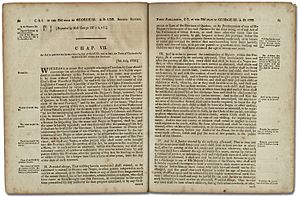Act Against Slavery facts for kids
Quick facts for kids Act Against Slavery |
|
|---|---|

Text of the Act Against Slavery
|
|
| Parliament of Upper Canada | |
| An Act to prevent the further introduction of Slaves, and to limit the Term of contracts for Servitude within this Province | |
| Citation | Statutes of Upper Canada 1793 (33 Geo. III), c. 7 |
| Date of Royal Assent | July 9, 1793 |
| Related legislation | |
| Slave Trade Act 1807 (United Kingdom); Slavery Abolition Act 1833 (United Kingdom) | |
| Status: Spent | |
The Act Against Slavery was an important law passed on July 9, 1793. It was created in Upper Canada, which is now part of Ontario, Canada. This law was a big step towards ending slavery in the British Empire. It stopped new slaves from being brought into Upper Canada. It also said that children born to enslaved mothers would become free when they turned 25.
Why This Law Was Needed
John Graves Simcoe was the first Lieutenant Governor of Upper Canada. He believed slavery was wrong. Before coming to Canada, he had spoken out against it in the British Parliament.
In 1792, there were not many enslaved people in Upper Canada. But their numbers grew as people called Loyalists moved north. These Loyalists were refugees from the south who often brought enslaved people with them.
In March 1793, Governor Simcoe heard a story about Chloe Cooley. She was an enslaved woman who was violently taken from Canada to be sold in the United States. This event made Simcoe even more determined to end slavery.
However, some members of the Legislative Assembly owned enslaved people. They did not want to fully abolish slavery. So, the new law was a compromise. Most of the law's text was written by John White, who was the Attorney General. At least six of the 16 assembly members owned enslaved people.
What the Law Did
The official name of the law was An Act to Prevent the further Introduction of Slaves and to limit the Term of Contracts for Servitude within this Province. It had two main parts:
- No new enslaved people could be brought into Upper Canada.
- Children born to enslaved mothers after the law was passed would become free when they turned 25 years old.
This law was very important. It made Upper Canada the first place in the British Empire to pass a law that helped free enslaved people. The Act stayed in effect until 1833. That year, the British Parliament passed the Slavery Abolition Act, which ended slavery in most parts of the British Empire.
After the Act
In 1798, a politician named Christopher Robinson tried to pass a new bill. This bill would have allowed more enslaved people to be brought into Upper Canada. The Legislative Assembly approved it, but the Legislative Council stopped it. The bill did not become law.
Many Black Canadians volunteered to fight in the War of 1812. In 1819, the Attorney General, John Robinson (Christopher's son), made an important statement. He said that Black residents were free just by living in Canada. He also said that Canadian courts would protect their freedom.
See also

